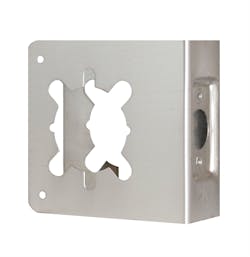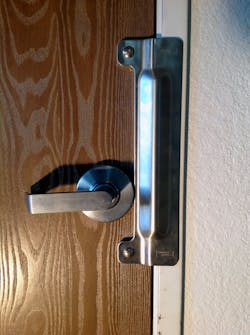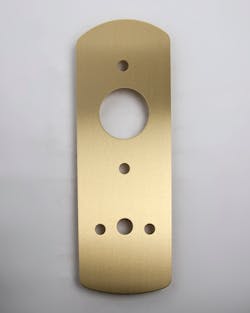If you think of security products like a football team, there’s no question that locks are the all-pro quarterbacks, the main attraction. Nonlocking door hardware, such as levers and hinges, tend to be like linemen and noticed only when they fail.
Then, there are other products that are like taxi squad players — they don’t even come into play until necessary, but they can save the day. The public might never have even heard of these products or acknowledge their existence, but pros in the industry know them well.
“Probably anybody with a lockshop is going to have some of these in stock,” says Jeff Loss, AHC, CSI, who is the owner and president of D.A. Loss Associates, a manufacturer’s representative.
Locksmith Ledger recently spoke with Loss about three of these ancillary door hardware products — door wraps, latch guards and remodeler plates — and what locksmiths and security pros should know about their use and ordering them.
All are aimed at upgrading a door. Latch guards, or lock guards, are meant to protect locks or strikes on exterior doors from attack, while door wraps, or wrap plates, are aimed at extending the life of a door not quite ready for replacement. Remodeler plates have improved appearance as their primary function in covering up previous installation work when swapping out hardware.
Several manufacturers make these products, and Loss says any builders hardware distributor and most security wholesalers carry them.
Door Wraps
Locksmith Ledger: When would I want to use a door wrap?
Jeff Loss: Typically, a door wrap is used to mount a new lock, hinge or strike onto a door where the door wrap serves to reinforce a damaged door or provide new hole locations for that lock.
LL: What door types would allow for the use of a door wrap?
Loss: Typically, any flush wood or metal door or any door that has a stile width of 6 inches or more. Door wraps can be 1–6-1/2 inches in width, so the door and existing hardware conditions have to be taken into consideration. You have to see whether the door is worth saving or, if you have a stile-and-rail door, the door wrap that you would use to accommodate whatever lock you wanted to use wouldn’t fit on the door stile any longer. The locksmith has to look at how much room is on that door where the lock is and make sure that whatever door wrap they use will fit on that stile and that something else isn’t in the way. Typically, door wraps are going to go on a flush door — your basic wood or hollow metal door.
LL: What different types of door wraps are available?
Loss: There are a number of different types depending on the door dimensions, such as the stile width and thickness; door materials, such as wood or metal; lock type, such as cylindrical or mortise; and the hole spacings for the various lock brands and types. Door wrap models always are being developed to accommodate the various manufacturers’ new push-button and electronic lock offerings. There also are door wraps that accommodate the strike for a pair of doors as well as door wraps for hinges.
LL: Are there special considerations for electronic locks with respect to wraps?
Loss: No. It’s just a different size lock. A standard cylindrical lock will have a 2-1/8-inch hole for the lock and then a couple of holes for the through bolts. When you have a keypad lock or a battery card lock, then the lock is 6 inches high or whatever it is, and more holes are in the door to accommodate the mounting holes or the wires.
LL: When ordering, what do locksmiths have to know about door wraps?
Loss: The four things you must consider:
- Door material
- Door-stile width, thickness, etc.
- Type of lock — the manufacturer and model you want to mount
- Finish
Most door wraps probably are for cylindrical locks. Cylindrical lock through-bolt spacings can be different among manufacturers, but most cylindrical locks will have a 2-1/8-inch hole through the bore in the face of the door. They’re going to have the latchbolt hole. That’s all kind of universal. The above considerations also apply to mortise locks, but in mortise, spacings are different between the cylinder and trim and whether you use a rose behind the lever or a full escutcheon plate. You’re just going to have more mortise lock types of door wraps.
LL: What finishes apply to door wraps?
Loss: Standard finishes include 630 brushed stainless, powder-coat black and dark brown. Other architectural finishes, such as US10, 4 and 3, also are available.
LL: What codes pertain to door wraps?
Loss: There is no fire rating for a door wrap, and there’s no UL listing. The requirements for fire-rated doors can be somewhat of a gray area, so, when in doubt, contact the [Authority Having Jurisdiction]. In my career, however, I’ve never run into a fire-rated door where a door wrap couldn’t be used because of the rating.
Latch Guards
LL: What applications would be best suited for latch guards?
Loss: Any out-swinging exterior door that has a mortise or cylindrical lock is a good candidate for a latch guard. It’s a good rule of thumb if you want as a building owner to feel more secure. In the specification work that we do, a latch guard is always part of the hardware package for these types of doors.
LL: What different types of latch guards are available?
Loss: Basic types include models for mortise locks, cylindrical locks, aluminum door locks and doors that have electric strikes. In case of a strike, the guard is designed to mount over the electric strike housing, which can protrude from the face of the door and frame. Latch guards can have through-bolt mounting or welded studs to accept a bolt from the nonsecure side. Both are going to do the job. I think one looks nicer than the other, but it’s just a preference — two different ways of doing things. Some latch guards also can be ordered with a pin on the frame side that goes into a predrilled hole in the frame. The pin helps to keep the door and frame from being spread apart by a crowbar.
LL: What do locksmiths have to know about latch guards with respect to ordering?
Loss: Four things, again:
- The lock type
- Electric strike type, if used
- How much room is on the pull side of the door next to the lock rose or escutcheon. The latch guard has to fit next to or sometimes partially around the rose or escutcheon.
- Finish requirement
LL: What about finishes for latch guards?
Loss: Steel, brushed stainless steel, powder-coat brown and brass-plated steel are the options. Most latch guards are steel or stainless steel.
LL: Do any code considerations apply to latch guards?
Loss: Not to my knowledge.
Remodeler Plates
LL: What applications most likely will require a remodeler plate?
Loss: Any door where a new lock type is mounted to an existing door that doesn’t exactly match the lock being replaced. Remodeler plates are particularly popular for doors where keypad or card locks are being retrofitted, because they tend to cause more scarring than other locks. Many remodeled hotel room doors that have new card locks will have custom remodeler plates provided in architectural finishes.
Loss: Typically, remodeler plates are used to mount a new lock to an existing door where holes and scars from previous hardware have to be covered up. In that, they’re similar to a door wrap. Remodeler plates, however, mount to both sides of the door. They can be from 3-1/2 inches wide by 4-1/2 inches high to 5 inches wide by 15 inches tall, depending on the lock type and door conditions.
LL: What do locksmiths have to know about ordering remodeler plates?
Loss: Five things here:
- Door type
- Finish
- Existing door conditions
- Lock being replaced
- New lock to be installed
LL: What about finishes for remodeler plates?
Loss: As with door wraps, standard finishes include 630 brush stainless, powder-coat black and dark brown. Other architectural finishes, such as US10, 4 and 3, also are available.
Will Christensen | Senior Editor
Will Christensen is senior editor at Locksmith Ledger International. He has been an editor and reporter at magazines and newspapers for more than 30 years.









